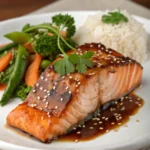Ingredients
Method
Preparation
- Whisk together miso paste, mirin, sake, brown sugar, rice vinegar, and sesame oil in a medium bowl. The mixture should be smooth and well-combined, with no lumps of miso remaining.
- Pat salmon fillets completely dry with paper towels. Place them in a shallow dish or resealable bag, then pour the marinade over the fish, ensuring all surfaces are coated.
- Refrigerate for at least 30 minutes, turning once halfway through.
- Remove salmon from refrigerator 15 minutes before cooking to bring to room temperature.
Cooking
- Preheat your oven to 425°F (220°C) and line a baking sheet with parchment paper. Reserve the excess marinade for basting during cooking.
- Remove salmon from marinade, allowing excess to drip off. Place fillets skin-side down on the prepared baking sheet.
- Bake for 12-15 minutes, depending on thickness. The internal temperature should reach 145°F (63°C) for food safety.
- Remove from oven and let rest for 2-3 minutes. Garnish with sliced green onions and sesame seeds.
Notes
To ensure optimal texture, avoid over-marinating and bring salmon to room temperature before cooking. For flavor variations, consider low-sodium, sugar-free, gluten-free, or paleo adaptations.
